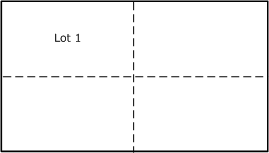Chapter 4 - Definition of “residential land”
4.1 The bright-line test would only apply to residential land. This is because residential land has been identified as an area where there is particular difficulty in enforcing the land sale rules due to the high churn of such property and high volume of transactions.
4.2 Restricting the bright-line test to residential land does raise boundary issues, particularly for mixed-use land and bare land. The goal of the definition of “residential land” is to appropriately define this boundary and ensure that residential property and property developments are covered while, at the same time, not overreaching and inadvertently capturing commercial, industrial or agricultural property.
Suggested change
4.3 To appropriately balance these factors, we suggest that the definition of “residential land” be:
- land that has a dwelling on it; or
- land for which there is an arrangement to build a dwelling on it;
- but does not include land that is used predominantly as business premises or as farmland.
4.4 The second criterion of this definition is intended to capture sales where the land is bare or currently being used for commercial or other purposes but is proposed to be developed into residential properties. This will ensure sales “off the plan” and other similar developments are captured.
4.5 This definition of residential land covers all land with a house on it but carves out those which are predominantly used for business purposes. The definition of “dwelling” would be the same as that currently used in the Income Tax Act 2007 but with adjustments to ensure that investors in serviced apartments are subject to the bright-line. However, a person who owns and operates serviced apartments as a business will not be subject to the bright-line due to the business premises exception.
Business premises and farmland definition
4.6 The current land sale rules have definitions of business premises and farmland that, with modification, we think are appropriate for use for the bright-line test.[4]
4.7 The suggested definition of “business premises” is land that is the premises of a business.
4.8 The suggested definition of “farmland” is land where the area and nature of the land disposed of means that it is then capable of being worked as an economic unit as a farming or agricultural business.[5]
Definition of “land”
4.9 The definition of “land” under current tax law is:
land —
(a) includes any estate or interest in land:
(b) includes an option to acquire land or an estate or interest in land:
(c) does not include a mortgage
4.10 This means “land” for the bright-line will include freehold and leasehold estates in land.
4.11 There is some uncertainty in the current definition of “land” as to whether it includes an interest in land.[6] We suggest clarifying that “land” does include an interest in land.
Example scenario: Development

Andrew buys an empty plot of land. He plans to develop the plot by subdividing it into four lots and building houses on each of the lots.
Andrew sells Lot 1 off the plan to Bob. One month later, Bob sells Lot 1 to Cara.
Lot 1 would be residential land and Bob would be subject to the bright-line test as Lot 1 is proposed to be used for residential purposes.
4 Sections CB 19 and CB 21 of the Income Tax Act 2007.
5 Capable of being worked as an economic unit as a farming or agricultural business means land capable of producing revenue sufficient to cover all costs of holding and operating the land, including the cost of capital employed and a reasonable recompense for the proprietor’s labour.
6 The current uncertainty is a result of an unintended legislative change during the Income Tax Act rewrite.


